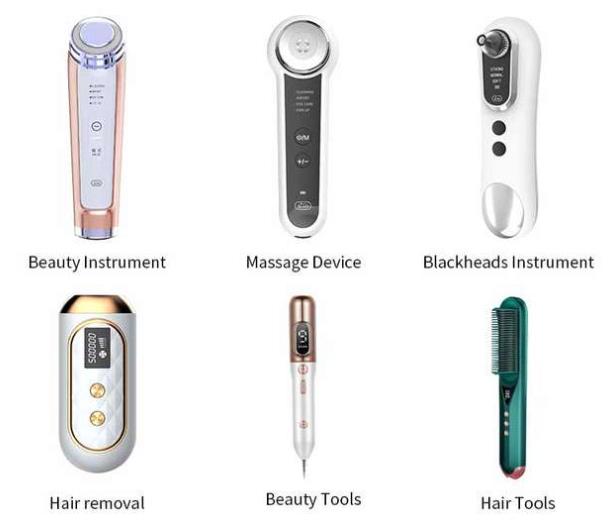The world of beauty instruments has evolved significantly in the past few years, with more and more companies relying on technology for innovation and manufacturing. While there are several manufacturing processes available, CNC machining and injection molding have become the preferred methods for creating high-quality, functional, and aesthetically pleasing beauty instruments. If you are involved in the design, development, or procurement of beauty instruments, understanding how CNC machining and injection molding can contribute to your product is crucial. In this blog post, we will explore the main parts that CNC machining and injection molding can provide for beauty instruments and their benefits.

Handles and grips are crucial parts of many beauty instruments, providing the user with a comfortable and secure grip while using the tool. CNC machining and injection molding can create handles and grips in various shapes and sizes, depending on the specific needs of the product. CNC machining offers the ability to shape the handle and grip into intricate designs and patterns, ensuring an ergonomic and aesthetically pleasing design. On the other hand, injection molding allows for mass production of identical handles and grips, reducing costs, and ensuring consistency.
Moulded components, such as casing, covers, and buttons, are common in many beauty instruments, providing protection to the internal parts and controls of the tool. Injection molding can create plastic parts in various colors, textures, and finishes, making the tool look high-end and distinctive. CNC machining can be used to create intricate designs on the moulded components, such as engravings or patterns, or to modify existing parts and improve the overall functionality of the instrument.
Many beauty instruments require metal components, such as blades, tweezers, or scissors. CNC machining can create precise and sharp edges on metal parts, ensuring a high level of accuracy and consistency. Additionally, CNC technology can create custom shapes and contour profiles that help to reduce manufacturing steps and manufacturing time, resulting in cost savings. In cases where the metal components need to be mass-produced, injection molding can create the metal parts in a wide range of shapes and sizes.
Customized inserts are used in beauty instruments to provide additional functionality or features to the product. CNC machining can cut and shape the customized inserts with high precision, ensuring that the inserts fit exactly according to the design specifications. Additionally, CNC machining allows for creating customized inserts with complex shapes, curves, and angles, which are not possible with traditional cutting and machining processes. Injection molding, on the other hand, can produce inserts with consistent quality, precise dimensions, and cost savings compared to CNC machining.
CNC machining and injection molding not only provide crucial parts for beauty instruments, but they also play a vital role in the final assembly of the product. CNC machining can help to create binding mechanisms, fasteners, and joining components to ensure a seamless and secure fit. Injection molding can create plastic housings for electronic or mechanical components, creating a perfect fit and reducing the number of assembly steps. Both CNC machining and injection molding can help in reducing manufacturing time and costs while ensuring a high-quality final product.
As we have seen in this blog post, CNC machining and injection molding play a crucial role in the manufacturing of beauty instruments. They can create various parts, ranging from handles, molded components, and metal parts, to customized inserts and final assembly components. The combination of these two technologies results in products that are high-quality, functional, and aesthetically pleasing while reducing manufacturing time and costs. As a mechanical engineer, buyer, or designer, understanding these manufacturing processes can help you create products that meet your customers’ needs, offering them a unique and enjoyable experience.
Here are 20 well-known beauty instrument brands classified into different categories along with their websites. Please note that the list includes both United States and Israel-based brands.
Facial Cleansing Brushes:
a. Clarisonic – https://www.clarisonic.com/
b. Foreo – https://www.foreo.com/
c. Proactiv – https://www.proactiv.com/
Hair Removal Devices:
a. Philips – https://www.usa.philips.com/
b. Tria Beauty – https://www.triabeauty.com/
c. Silk’n – https://silkn.com/
Facial Massagers:
a. NuFACE – https://www.mynuface.com/
b. ReFa – https://www.refausa.com/
c. GloPRO – https://www.beautybio.com/
Anti-Aging Devices:
a. JeNu – https://www.jenu.com/
b. DERMAFLASH – https://dermaflash.com/
c. Baby Quasar – https://www.babyquasar.com/
Skin Cleansing Devices:
a. PMD Beauty – https://www.pmdbeauty.com/
b. Michael Todd Beauty – https://www.michaeltoddbeauty.com/
c. Skin Scrubber – https://www.skin-scrubber.com/
Hair Styling Tools:
a. Dyson – https://www.dyson.com/
b. ghd – https://www.ghdhair.com/
c. T3 – https://www.t3micro.com/
Teeth Whitening Devices:
a. Crest – https://crest.com/
b. SmileDirectClub – https://smiledirectclub.com/
c. GLO Science – https://gloscience.com/
Nail Care Tools:
a. Tweezerman – https://www.tweezerman.com/
b. OPI – https://www.opi.com/
c. Cuccio – https://cuccio.com/